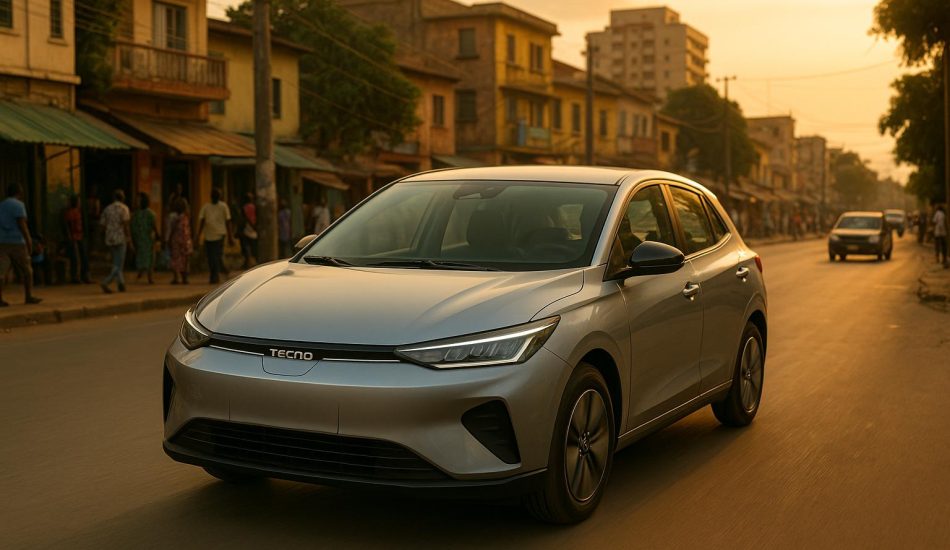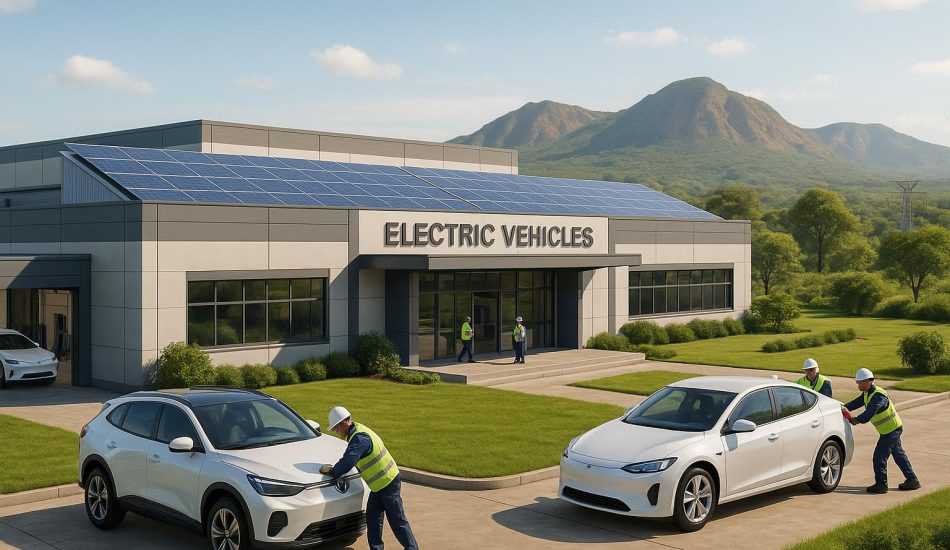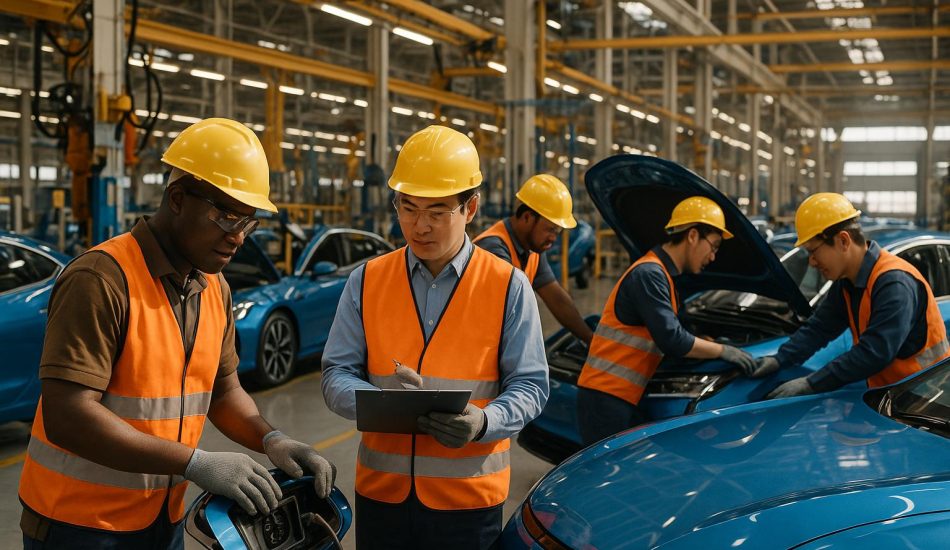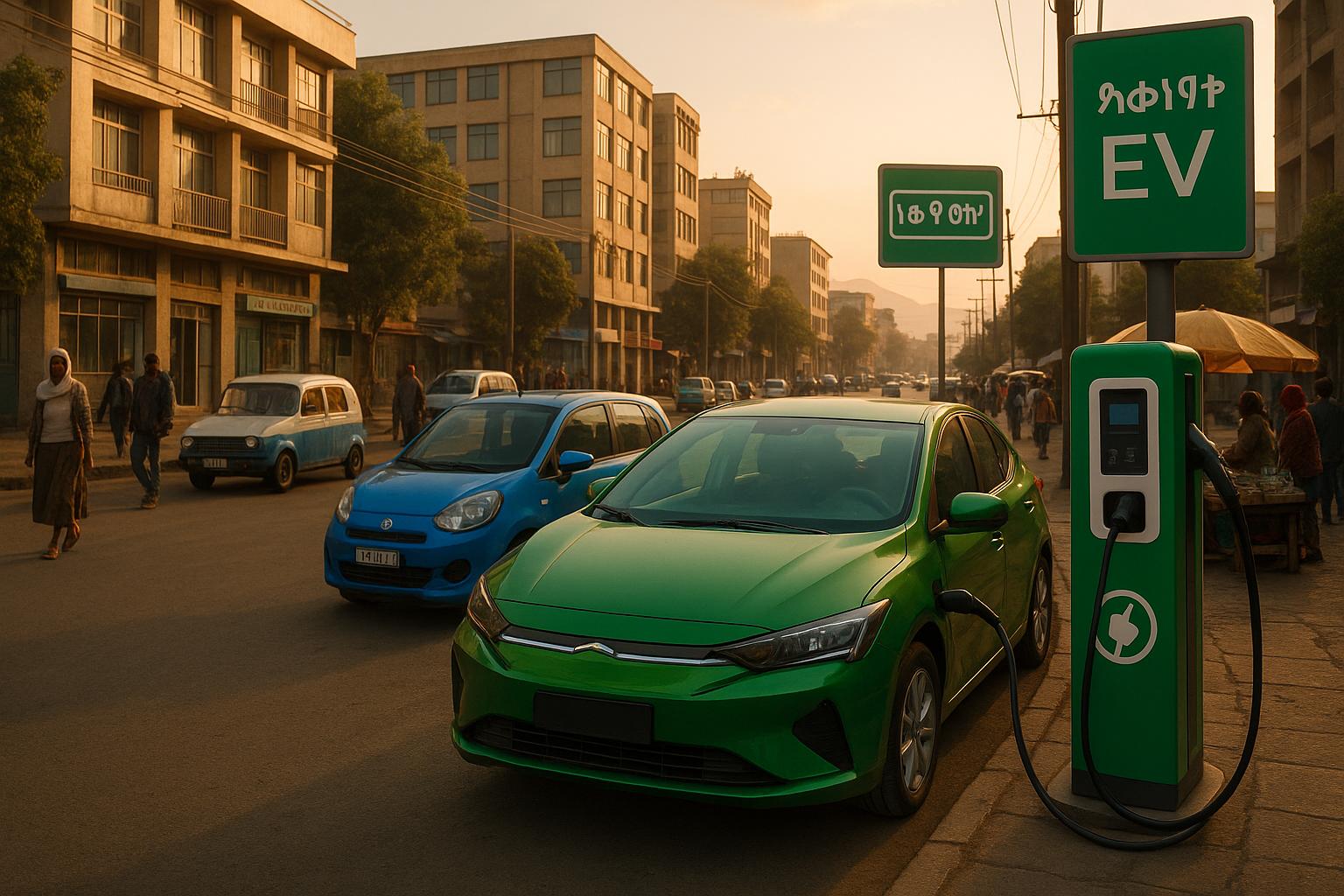
Ethiopia is leading Africa in shifting to electric vehicles (EVs) by banning gas-powered car imports since January 2024. This bold policy aims to cut $5 billion spent annually on fuel imports and promote cleaner mobility, leveraging the country’s 96% hydropower-generated electricity. The government plans to replace 95% of fuel-powered cars with EVs by 2030, supported by tax incentives and reduced tariffs for EV imports.
However, challenges persist:
- Infrastructure gaps: Only 50 charging stations exist, with rural areas lacking electricity access.
- High costs: EVs remain unaffordable for most, with used models starting at $35,000.
- Regulatory issues: Black markets for banned vehicles and unclear rules slow progress.
- Skills shortage: Few mechanics are trained to service EVs.
Efforts to address these include interest-free leasing programs, local EV assembly plants, and training initiatives. Ethiopia’s experience offers lessons for other nations aiming to reduce fuel dependency and adopt cleaner transportation solutions.
Ethiopia bans imports of gas-powered private vehicles, but switch to electric is a bumpy ride
Major Problems with Ethiopia’s EV Switch
Ethiopia’s plans to transition to electric vehicles (EVs) come with plenty of promise, but the road ahead is riddled with challenges. From infrastructure gaps and high costs to regulatory hurdles and disruptions in the local car market, the country faces significant obstacles that could hinder its progress.
Lack of Charging Stations and Power Grid Limitations
One of the biggest hurdles is the lack of charging stations and reliable electricity. By April 2025, Ethiopia had only 50 urban charging stations, and while 96% of city dwellers have access to electricity, rural access is shockingly low at just 12%. Even for those connected to the grid, frequent blackouts – averaging 46 hours – add to the challenge. These issues threaten the government’s ambitious goal of growing EV imports from 100,000 to 500,000 by 2030.
As a motorcycle taxi rider bluntly put it:
"We don’t have electricity in our village."
To address this, the government plans to install charging stations every 50 to 120 kilometers. However, funding remains a sticking point. Yizengaw Yitayih, a sustainable mobility expert with the transport ministry, highlighted the need for international support:
"If we get international loans or grants, we can expand charging stations to rural communities, thereby advancing the adoption of electric vehicles throughout the country."
Adding to the infrastructure woes is a shortage of trained EV mechanics, which discourages potential buyers from making the switch.
High Costs and Limited Financing Options
Affordability is another major barrier. Even with reduced tariffs, EVs remain out of reach for most Ethiopians. Used models cost over $35,000, while new ones range from $38,000 to upwards of $100,000. Considering that only about 5% of adults in Ethiopia have access to formal financing, these prices are prohibitive for the majority.
Some innovative financing solutions are emerging. In January 2025, Utopia Technology introduced the "Utopia Green Fund", which offers interest-free leases and savings options to make EVs more accessible. Adonic Werku, the company’s founder, explained:
"We are facilitating interest-free car leases for up to 10 years, making it easier for Ethiopians to transition to electric vehicles."
Another initiative comes from Mobilit-E, which provides loan plans for purchasing BYD vehicles, requiring a 20% down payment. However, broader economic challenges, like currency devaluation and rising import costs tied to Ethiopia’s market-based foreign exchange system, continue to strain the automotive market. Economist Samson Berhane captured the hesitation among buyers:
"When [Ethiopians] buy a car, they ask themselves whether they will be able to resell it. Once you buy an electric car, its value will decrease."
Enforcement Challenges and Market Gaps
Ethiopia made headlines by becoming the first country to ban the import of internal combustion engine vehicles in January 2024. But enforcing this bold policy has proven difficult. Fragmented government agencies and unclear legislation have fueled a black market for banned vehicles, undermining the transition. On top of that, complicated registration and road use rules make it harder to sell smaller EVs like scooters.
Yasaki Yuma, CEO of the Ethiopian e-mobility company Dodai, summed up the frustration:
"Customers and sectors both suffer from lack of infrastructure and regulations for e-mobility while we have to deal with it."
Consumer awareness is also a problem. Many people don’t fully understand EV technology or how to maintain these vehicles, which adds to their reluctance. The scarcity of trained mechanics only makes matters worse. Economist Samson Berhane noted:
"Very few people are willing to take the risk of buying electric cars due to the lack of infrastructure, shortage of mechanics specialized in EV maintenance and the flooding of the market with Chinese brands that have questionable details and long-term visibility."
Impact on Local Car Businesses
The shift to EVs is shaking up Ethiopia’s traditional automotive industry. Local car dealers are struggling to adapt, facing pressure to either switch to EV production or shut down. Many are grappling with spare parts shortages and the rapid influx of Chinese EVs, which often come with limited support networks and questionable reliability.
Adis Yohannes, an online car dealer in Addis Ababa, expressed his frustration:
"The policy came ‘damn too early’ and described a ‘nagging sense to sell it [an EV] soon because of shortage and expensiveness of spare parts.’"
The government’s target of importing 500,000 EVs per month by 2030 adds further strain on local businesses, raising concerns about whether they can keep up with the growing market while providing quality service and technical support. The dominance of Chinese brands, often criticized for their lack of long-term reliability, only complicates the situation.
sbb-itb-99e19e3
How to Fix Ethiopia’s EV Problems
Ethiopia faces several hurdles in its electric vehicle (EV) transition, but there are clear paths forward. By focusing on infrastructure, affordability, and skill development, and fostering collaboration among the government, private sector, and international partners, the country can make significant progress.
Creating Better EV Infrastructure
Ethiopia has already started expanding its EV infrastructure, with Ethio Telecom leading the charge in Addis Ababa. In April 2025, the company unveiled its second charging facility, equipped with 16 high-capacity chargers compatible with European-standard EVs. This brings the city’s total capacity to 32 vehicles charging simultaneously.
The government is also setting ambitious goals for nationwide coverage. The Ministry of Transport plans to install charging stations every 31 to 75 miles (50 to 120 kilometers), catering to various user needs with home, public service, and commercial charging options.
Frehiwot Tamiru, CEO of Ethio Telecom, highlighted the importance of this effort:
"This initiative aligns with Ethio Telecom’s vision as a leading digital solutions provider and is part of our Digital Ethiopia journey."
Building a comprehensive EV charging network across Sub-Saharan Africa, including Ethiopia, will require an estimated $3.5 to $8.9 billion, according to a Shell Foundation report. However, Ethiopia’s access to some of the world’s cheapest electricity – less than $0.01 per kilowatt-hour – could make this investment transformative for the country’s EV infrastructure.
Making EVs Cheaper for Buyers
Improving infrastructure is just one part of the puzzle; making EVs more affordable is equally crucial. Ethiopia has introduced tax reforms to reduce costs for buyers. Currently, EVs are exempt from value-added tax, surtax, and excise tax. The government has also implemented a tiered customs duty system: completely knocked-down (CKD) kits for local assembly are exempt, semi-knocked-down (SKD) kits face a 5% duty, and fully built imported EVs are subject to a 15% duty.
Local assembly plays a key role in cost reduction. By assembling vehicles domestically, costs can drop by up to 20%. Partnerships with Chinese manufacturers are helping make this a reality. For example, in June 2023, Belayneh Kindie Motors (BKM) opened an assembly plant in Debre Birhan, producing 12-seat minibuses and 12-meter buses in collaboration with China’s Golden Dragon Company. This initiative has already created over 500 jobs.
Eyuel Bogale, assistant project coordinator at Ethiopia’s Ministry of Transport, noted:
"Chinese investment in Ethiopia’s electric vehicle sector has been transformative, particularly in job creation, industrial development, and technology transfer."
To further encourage investment, the government is offering free or leased land for EV after-sales services, making the market even more appealing to both domestic and foreign companies.
Training People and Building Local Skills
Closing the skills gap is essential for Ethiopia’s EV market to thrive. Green Tech Africa has taken the lead in this area, launching training programs to equip young technicians with EV-specific skills. In 2023, the company partnered with SOS Children’s Village to train 25 young people in EV maintenance. The three-month program at the SOS vocational college covered electronic devices, battery cells, and mechanical components.
Fitsum Deressa, General Manager of GreenTech Ethiopia, explained:
"The major objective of the training was to provide an inclusive training for young auto technicians to fill the gap that is seen in the sector."
Green Tech Africa plans to expand its efforts, aiming to train over 300 experts annually. It has also established EV clinics to address specialized maintenance needs.
Other organizations are contributing as well. Marathon Motor Engineering (MME) leverages the Hyundai Cyber Academy (HCA) Program for technical training, showcasing how international partnerships can facilitate knowledge transfer. Professor Hailu Abebe from Addis Ababa Science and Technology University emphasized the importance of these efforts:
"Technicians trained on fuel vehicles must acquire EV-specific skills."
These programs are laying the foundation for a skilled workforce to support Ethiopia’s growing EV market.
How EV24.africa Helps Ethiopia’s Market
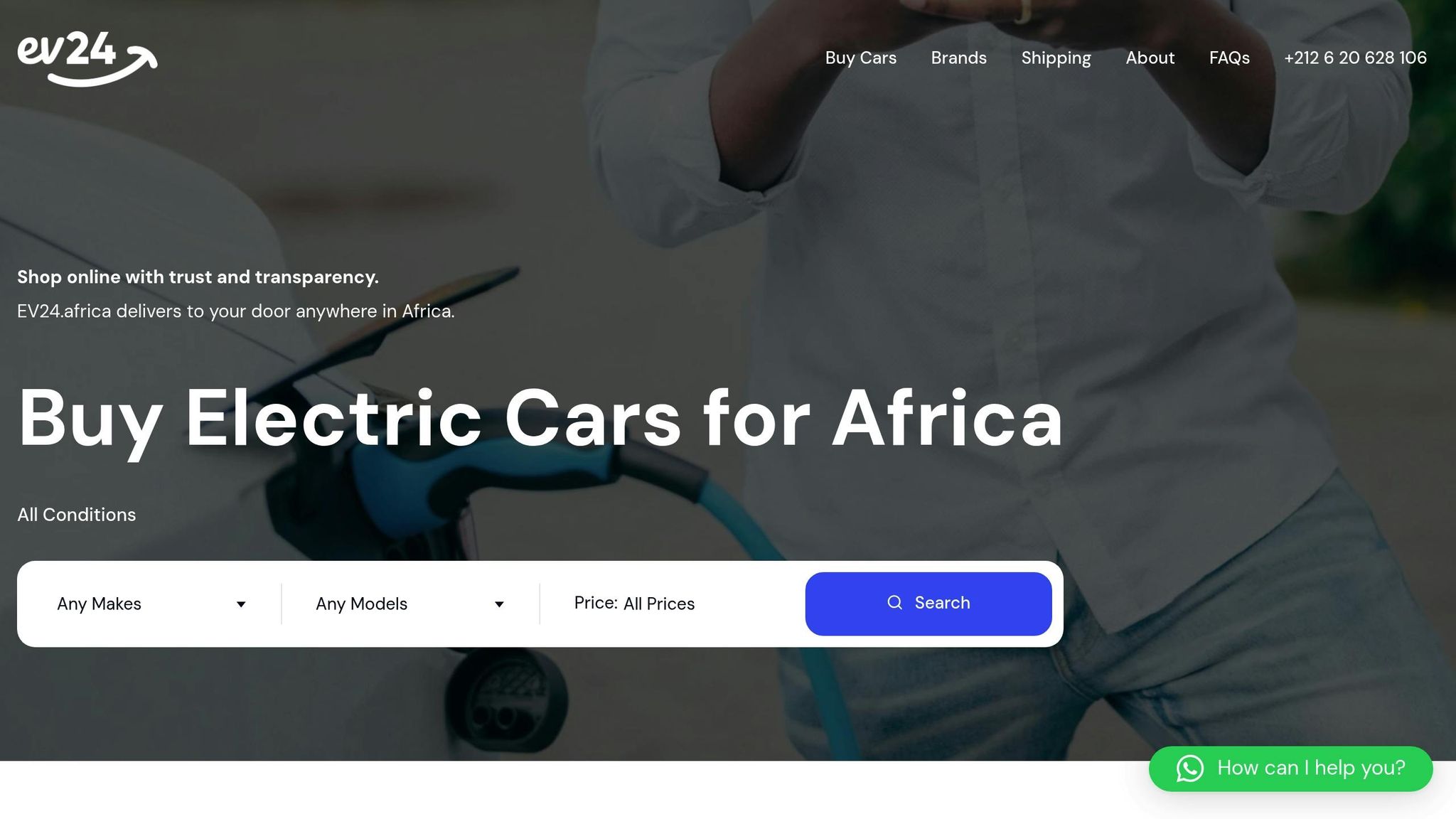
On top of infrastructure, affordability, and training improvements, platforms like EV24.africa are playing a vital role in Ethiopia’s EV transition. EV24.africa addresses supply chain challenges by offering a wide range of electric vehicles from brands like Tesla, BYD, Leapmotor, ROX, Dongfeng, Geely, Hyundai, Toyota, and Suzuki. Buyers can choose from new and used vehicles, with transparent pricing and specifications.
Flexible financing options make EVs more accessible, while customer reviews help buyers better understand EV technology and maintenance requirements. Additionally, EV24.africa delivers vehicles across all 54 African countries, giving Ethiopian buyers access to options that may not be available locally. For dealerships, the platform provides a way to reach more customers, opening up new revenue opportunities in a rapidly changing automotive market.
What’s Next: Ethiopia’s Example for Africa
Ethiopia’s decision to ban internal combustion engine vehicles marks a bold step toward embracing electric mobility, setting an example for other African nations. This forward-thinking move serves as a potential guide for countries across the continent aiming to reduce their reliance on fossil fuels.
Expected Benefits
Ethiopia stands to gain economically from this transition. The country currently spends over $6 billion annually on fuel imports. Redirecting this expenditure into the domestic economy could spur growth. With an electricity grid that is 99% renewable and among the most affordable globally – costing just $0.03 per kilowatt-hour – Ethiopia is uniquely positioned to power its transportation sector in a sustainable and cost-effective manner.
There’s also a public health angle. Air pollution caused approximately 41,000 premature deaths in Ethiopia in 2017, accounting for nearly 8% of all deaths. In Addis Ababa alone, 2,700 people died prematurely due to air pollution in 2017, with estimates suggesting this number could rise to 6,000 by 2025 if no action is taken. Transitioning to zero-emission vehicles could significantly reduce these troubling figures.
The government’s ambitious goals highlight its commitment to this shift. Initially, Ethiopia planned to import 148,000 electric cars and 48,555 electric buses by 2030. However, rising demand led to an upward revision of this target to 439,000 electric vehicles. Despite hurdles, the growing adoption of EVs signals progress.
But alongside these promising benefits, challenges remain.
Remaining Risks and Problems
Ethiopia’s EV journey is not without obstacles. A major issue is the lack of charging infrastructure – there are currently only 13 public EV charging stations across the entire country. Without expanding this network, the risk of reverting to internal combustion vehicles looms large.
High costs and limited financing options also present significant barriers. Second-hand EVs often exceed $35,000, while new models range between €39,000 and €110,000. With only 5% of Ethiopian adults accessing formal financial institutions or mobile money services, many potential buyers are unable to afford these vehicles.
Rural communities face even greater challenges. Limited access to electricity in these areas creates a stark divide, where urban centers benefit from EV adoption while rural regions are left behind.
Shantha Bloemen, Managing Director at Mobility for Africa, highlighted the complexities of coordinating such a massive transition:
"It’s not just the ministry of transport, it’s the ministry of energy, industry, local government, finance, and getting them all together on the same page is slightly difficult."
Ethiopia’s pioneering status as the first country to ban internal combustion engine vehicle imports also comes with unique challenges. Without a precedent to follow, the nation is navigating uncharted territory, testing whether its aspirations can match its institutional and infrastructural readiness.
What Other African Countries Can Learn
Ethiopia’s experience offers valuable lessons for other African nations looking to adopt electric vehicles. Its progress demonstrates how policy incentives and market adjustments can drive electrification, even in difficult contexts. Already, several countries are introducing tax breaks to make EVs more affordable.
Building a robust charging network and ensuring grid stability are critical steps. Local manufacturing and assembly can also help reduce costs and create jobs. For instance, BYD’s collaboration with Ethiopia-based MOENCO to introduce five car models shows how international partnerships can enhance local capacity.
Coordinating efforts across multiple government sectors is essential. A cohesive approach can prevent policy and implementation gaps. Initiatives like the Utopia Green Fund, launched in January 2025, provide creative solutions to financial barriers by offering interest-free lease payments and savings-based financing options with terms of up to 10 years.
Rural electrification must also be prioritized. Expanding access to electricity is crucial for inclusive adoption, especially since used cars currently make up about 85% of vehicles on Ethiopian roads.
If Ethiopia succeeds, its transition to electric mobility could inspire similar shifts across Africa, potentially reshaping the continent’s transportation sector and reducing its reliance on fossil fuels.
FAQs
What is the Ethiopian government doing to improve access to EV charging stations, particularly in rural areas?
The Ethiopian government is making strides to expand access to EV charging stations, with plans to set them up every 30 to 75 miles across the nation. The initial focus is on urban centers, with a gradual rollout to rural areas as part of a long-term infrastructure strategy.
To back this effort, new regulatory policies have been introduced to attract investment in charging networks and guarantee accessibility for diverse communities. These measures align with Ethiopia’s larger goal of boosting electric vehicle adoption and embracing a more environmentally friendly transportation system.
How does the high price of electric vehicles affect their adoption in Ethiopia, and what financing options could help make them more accessible?
The steep cost of electric vehicles (EVs) poses a significant hurdle to their adoption in Ethiopia. Brand-new EVs typically cost anywhere from $37,000 to $108,000, while even used models often surpass $34,000 – figures far beyond what most Ethiopians can afford. This challenge is even more pronounced in rural areas, where economic hardships are often more severe.
On top of that, financing options for EVs remain limited. Many local banks have yet to introduce loan programs specifically designed for EV purchases, leaving potential buyers with few avenues to secure the funds they need. Expanding access to affordable financing, such as low-interest loans or government-backed subsidies, could be a game-changer in making EVs a viable option for more people across the country.
What challenges is Ethiopia facing in enforcing its gas-powered vehicle import ban, and what steps is the government taking to tackle illegal imports?
Ethiopia is grappling with hurdles in enforcing its ban on gas-powered vehicle imports, largely due to the thriving black market for these cars. Smuggling and illegal sales continue to undermine the ban, complicating the country’s efforts to move away from fossil fuel-driven transportation.
In response, the government has stepped up its game by tightening import regulations, ramping up customs inspections, and strengthening border controls. At the same time, officials are pushing for the adoption of electric vehicles (EVs) by rolling out supportive policies and offering incentives. However, tackling illegal imports isn’t straightforward – it demands a combination of tougher enforcement and public awareness campaigns to encourage widespread acceptance of EVs.


